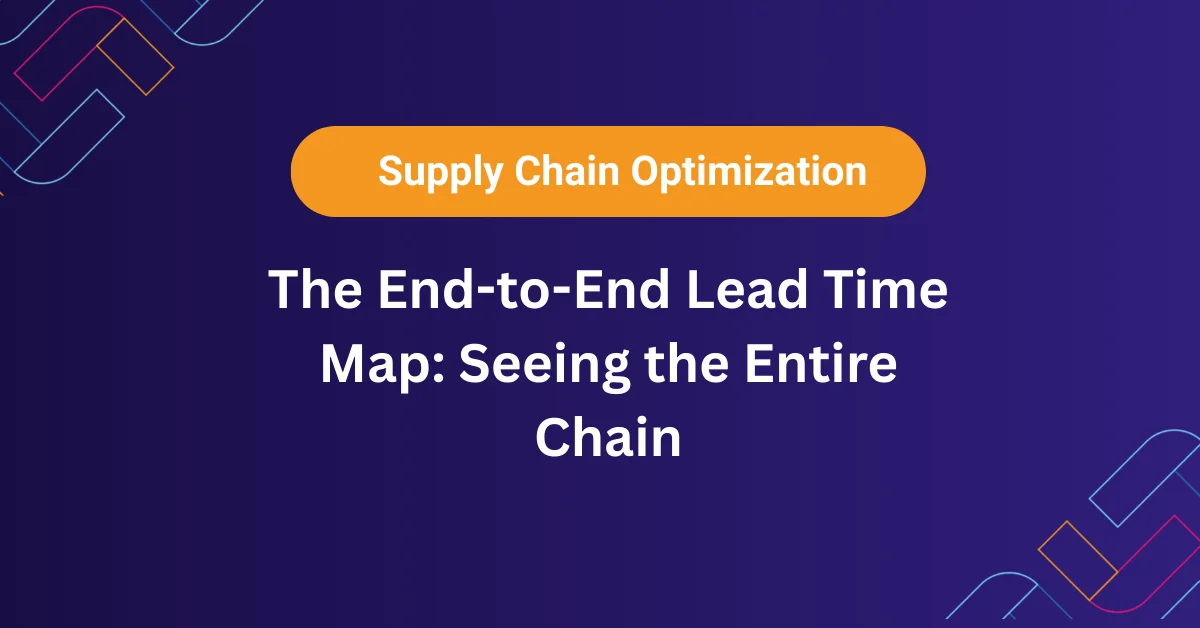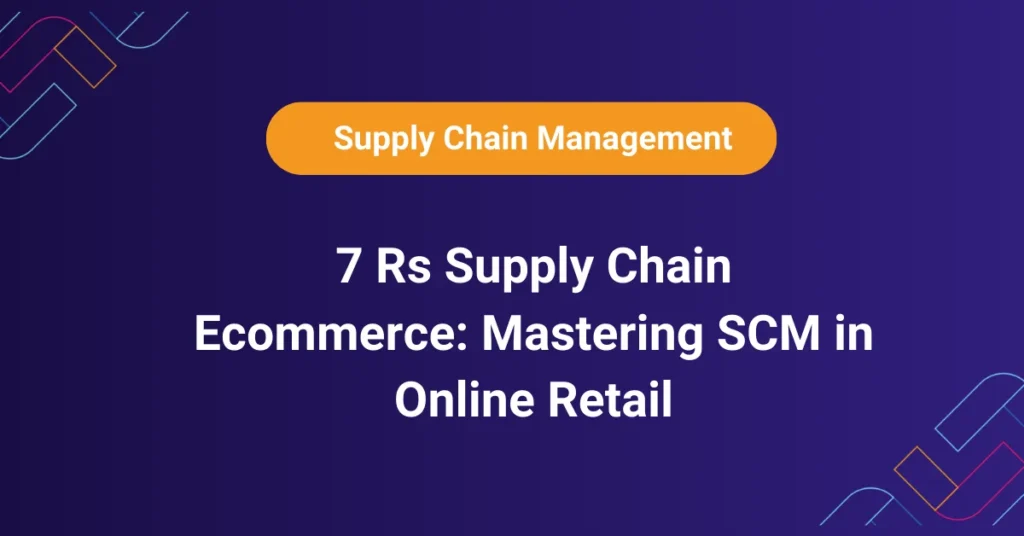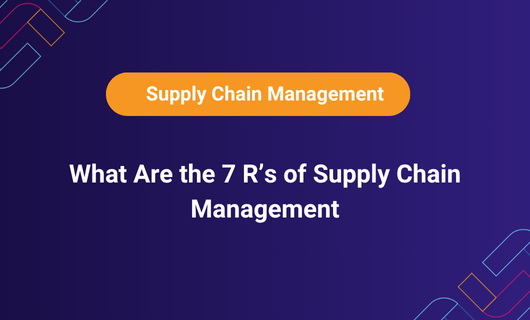That sinking feeling is all too familiar—you’ve approved the purchase order, yet the arrival date for your best-selling product feels more like a guess than a promise. You hope the shipment arrives before a stockout, keeping revenue on track. For any serious eCommerce brand, mastering inventory management in SCM is essential to reduce lead time ecommerce challenges. This isn’t about frantic supplier emails; it’s about turning lead time from a risky unknown into a predictable, optimized process through data-driven control.
The End-to-End Lead Time Map: Seeing the Entire Chain
The most common error brands make is myopic focus on the “production lead time” quoted by their supplier. This figure is merely one chapter in a much longer story. Total Lead Time encompasses the entire journey from the moment your team decides to place a purchase order to the moment sellable inventory is safely stowed on the shelf at your 3PL and is available to promise on your Shopify store. Overlooking this holistic view means you’re constantly blindsided by hidden waits that silently consume weeks of your calendar. True lead time reduction in ecommerce begins with ruthless visibility.

How do I map total lead time end‑to‑end?
Apply inventory management in SCM principles by breaking your timeline into five distinct, measurable phases:
-
Internal Processing: The days your team spends finalizing forecasts, raising the PO, and securing internal approvals.
-
Supplier Processing: The period your vendor needs for order confirmation, sourcing raw materials, and slotting your order into their production schedule.
-
Production & QC: The duration of manufacturing, mandatory quality control checks, and final packaging.
-
Transportation: The time consumed by ocean or air freight, port congestion, and inland trucking to your warehouse.
-
Receiving & Putaway: The often-overlooked window your 3PL needs to unload containers, inspect goods, and scan them into storage.
Dissecting the Internal Bottlenecks: Where Your Weeks Hide
Before a PO ever reaches your supplier, internal inertia can derail your timeline. These self-inflicted delays are among the easiest to fix yet often cause the most significant holdups.
PO Approval Loops: How many stakeholders must sign off on an order? If key decision-makers are out of office or emails languish in inboxes, the entire process grinds to a halt.
Forecast Inaccuracy: Volatile order quantities based on gut feelings or poor data force constant re-negotiation with suppliers, effectively resetting the clock with every change.
Payment Processing: Cumbersome internal protocols for initiating wire transfers or processing invoices can delay your supplier from officially starting work on your order.
ROI Angle: Eliminating just three days from your internal processing cycle directly accelerates your cash conversion cycle, unlocking working capital that can be redirected into customer acquisition and growth.
Actionable Step: Implement a Takt Time for Procurement
Establish a strict, standardized rhythm for your ordering process to ensure multi-warehouse synchronization. For instance, mandate that all POs be raised, approved, and sent to suppliers within a strict 48-hour window following your weekly demand planning meeting. This discipline creates predictability for your team and sets clear expectations for your manufacturing partners.
Strategic Supplier Tactics: Partnership Over Pressure
The objective isn’t to strong-arm your supplier into an unrealistic deadline; it’s to cultivate a collaborative environment where a shorter lead time becomes a mutually beneficial goal.
Negotiate Realistic Lead Times: Arrive at the table armed with data, not demands. Use your historical lead time analysis to discuss specific phases. Instead of a vague “we need this faster,” ask a targeted question: “What would need to change to reduce your raw material sourcing window from 14 to 10 days?”
Leverage MOQs Wisely: Can MOQs increase lead time? Without a doubt. A massive Minimum Order Quantity might secure a slightly better unit cost, but it often necessitates a much longer production run, pushing your order further back in the queue. A smarter play is to split MOQs across multiple products or agree to smaller, more frequent production runs, even at a marginally higher cost. Remember, the immense cost of a stockout—lost sales, eroded customer trust, and rushed shipping—almost always dwarfs a minor per-unit price increase.
Consolidate Your Supply Base: Spreading orders across numerous factories makes you a small fish in a big pond. Focusing your volume on fewer, strategic partners elevates your importance, often granting you priority scheduling and more flexible terms when you need them most.
How do I negotiate realistic lead times?
Reframe the conversation around shared value in DRP-DTC-ecommerce operations. Propose a formal lead time reduction project: “If we can provide a firm 12-month rolling forecast and guarantee PO approvals within 48 hours, what is the fastest possible production time you can consistently commit to?” You’re removing their biggest headache—uncertainty—and in return, they give you priority status.
Navigating Freight, Customs, and The Final Mile
This segment is typically the most volatile and least understood. The decisions made here dramatically impact cost, speed, and predictability.
Incoterms Clarity: Your chosen Incoterms (e.g., FOB vs. EXW vs. DDP) legally dictate responsibility and liability for the shipment at every stage. Misunderstanding these terms leads to painful delays at port while parties scramble to figure out who pays for duties, tariffs, and unloading fees. FOB (Free On Board) is often a strategic sweet spot for growing brands, granting you control over freight logistics the moment goods are loaded onto the vessel.
How do I choose faster freight options? The decision always boils down to a cost-speed trade-off. Air Freight is incredibly fast but prohibitively expensive for most goods. Ocean Freight LCL (Less than Container Load) is cheap but slow and highly prone to delays. Ocean Freight FCL (Full Container Load) offers a middle ground of better reliability. For critical shipments, a hybrid approach is wise: air freight a small quantity to bridge a stockout gap while the bulk shipment travels by sea.
Customs Compliance: Incomplete or inaccurate customs paperwork is a guaranteed ticket to your shipment being held for days or even weeks. Partner with an experienced freight forwarder and triple-check that your commercial invoice, packing list, and HS codes are perfectly aligned to avoid costly holdups.
Actionable Step: Build a Freight Decision Matrix
Create a simple, actionable table to guide your team’s shipping decisions based on real-time inventory health.
| Inventory Status (Weeks of Stock) | Recommended Shipping Method | Key Rationale |
|---|---|---|
| < 2 Weeks (Critical) | Air Freight / Express | Prevent a stockout at all costs. Protect revenue and customer trust. |
| 2-4 Weeks (Warning) | Ocean FCL (Full Container) | Optimal balance of cost control and transit reliability. |
| 5+ Weeks (Healthy) | Ocean LCL (Less than Container) | Maximize cost-efficiency for non-urgent inventory. |
The Power of Pipeline Inventory: Your Strategic Buffer
Pipeline inventory, or pipeline stock, comprises all goods that have been ordered but have not yet arrived at your warehouse. It’s inventory in motion. Most brands treat this as a black box. Savvy brands manage it as a strategic asset and the ultimate key to lead time reduction.
What’s the role of pipeline inventory? Its core function is to decouple your planning from supply chain variability. By accurately accounting for every single unit in the pipeline, you can place new orders with absolute confidence, knowing precisely what is coming and when. This eliminates panic double-ordering, which creates a destructive bullwhip effect through your supply chain.
How to Manage It: This demands real-time visibility. Your tech stack—your WMS, OMS, or ERP system—must be configured to track inventory by its status: “On Order,” “In Transit,” “At Port,” “At 3PL Receiving.” This granular visibility is what powers accurate Available-to-Promise (ATP) calculations on your product pages, preventing overselling.
ROI Angle: Meticulous pipeline inventory management directly prevents both overstocking and catastrophic stockouts. This optimizes your inventory carrying costs—which can silently consume 20-30% of your inventory’s value annually.
Tracking What Matters: KPIs for Lead Time Reduction
You cannot improve what you do not measure. Vanity metrics are useless here. You need to track operational Key Performance Indicators (KPI) that directly correlate to lead time performance.
Total Lead Time (Days): The grand total from PO creation to 3PL receipt. Track this relentlessly by supplier and product category.
On-Time In-Full (OTIF) Rate: The percentage of orders that arrive complete and on the expected date. This measures reliability, which is just as important as raw speed.
Schedule Adherence: Tracks how often your supplier confirms your original production date and hits it without delays.
Forecast Accuracy: Improving this single metric has a cascading positive effect on nearly every other component of your lead time.
Which KPIs track lead time reduction?
Focus on Total Lead Time and OTIF Rate as your primary north star metrics. Monitor Forecast Accuracy as a leading indicator. A steady rise in forecast accuracy should, over time, manifest as a measurable reduction in your total lead time.
The Holiday Wildcard: Planning for the Inevitable
How do holidays affect lead times? Catastrophically. It’s not just your holidays; it’s your supplier’s and your freight forwarder’s. Chinese New Year, Golden Week, and Christmas shutdowns bring entire countries to a standstill for weeks. The lead time you have in October is fundamentally different from what you can expect in January. Failing to plan for this is operational malpractice.
Action: Maintain a shared international holiday calendar with your team and partners. For major holidays like Chinese New Year, you must front-load your orders aggressively. This means orders that would normally ship in February need to be placed in November and must ship by early January at the absolute latest.
Frequently Asked Questions
The biggest hidden cause is rarely the production time itself. It's usually a combination of inefficient internal processes—like slow PO approvals and inaccurate forecasting—coupled with a lack of visibility into the entire supply chain, including freight delays and 3PL receiving times. Most brands only see the tip of the iceberg.
Transform the conversation from a negotiation into a collaboration. Approach them with data on your shared timeline and offer value in return for faster turns, such as providing longer-term forecasts, committing to smaller and more frequent orders, or agreeing to faster payment terms. This makes you a preferred partner, not a difficult client.
Pipeline inventory is all the stock that has been ordered but is not yet in your warehouse. It acts as a strategic buffer.
The quickest win is to audit your freight strategy. For critical SKUs, switching from unpredictable ocean freight (LCL) to air freight can cut weeks off your timeline overnight. While more expensive, this cost is often justified to prevent a stockout that would sacrifice revenue and customer trust. It's a tactical fix while you work on long-term solutions.
These holidays can extend lead times by 4-6 weeks due to extended factory and port shutdowns. Effective planning requires you to front-load your orders significantly. For Chinese New Year, this means orders needing February shipment must be placed in November and must ship by early January to avoid massive delays.
Ready to Replace Guesswork with Certainty?
Stop letting supply chain delays dictate your growth and threaten your customer relationships. Brankit’s team of supply chain specialists is dedicated to helping brands like yours build predictable, efficient, and resilient logistics operations.
Schedule a free, no-obligation call with a Brankit supply chain analyst. We’ll help you map your total lead time and pinpoint your single biggest opportunity to reclaim weeks of time and unlock trapped cash flow.





